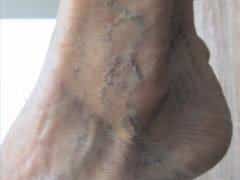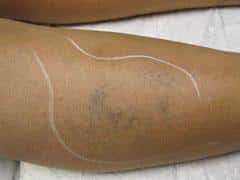Spider veins are very superficial small vessels ranging from less than a millimeter to about 3mm. They are usually red, blue and/or purple in color. Though they are not dangerous to a person’s health in any way, they can be visually bothersome to many people. Fortunately, there are simple treatments to address them.
The most common treatment used for spider veins is sclerotherapy. Sclerotherapy is a method where a substance is directly injected into the spider veins. The liquid injected into the veins can be a variety of different medications, including polidocanol, sodium tetradecyl sulfate, glycerin and hypertonic saline. Each medication has its pros and cons. At our clinic, we use Asclera which is polidocanol. Polidocanol has the advantages of being painless upon injection and has a very low risk of ulceration (breakdown of the skin) if injected outside the vein unlike hypertonic saline which can cause an intense burning sensation and has a higher risk of ulceration.
 Unsightly leg veins. These could be treated with multiple sclerotherapy sessions with great results.
Unsightly leg veins. These could be treated with multiple sclerotherapy sessions with great results. Untreated leg veins with matting (clustering of veins).
Untreated leg veins with matting (clustering of veins).The sclerosing agent is directly injected into each spider vein with a very small needle. Once inside the vessel, the medication usually causes irritation and inflammation of that vessel which then leads to scarring down of that vessel so that it closes and blood can no longer flow through it. This then causes the spider vein to disappear. Treatment time will depend on how extensive the spider veins are but typically takes about 30 minutes. Pain is very minimal since the needles used are very small and as long as hypertonic saline is not used. Patients usually need between 1-3 treatment sessions. Results can last a few years but eventually either new spider veins will appear and/or previously treated vessels can start opening up again.
If spider veins are much smaller than 1 mm in diameter, it may be difficult to place the needle directly into the spider vein. In these cases, lasers such as an Intense Pulse Light (IPL) or Pulsed Dye Laser (PDL) can be used. Vessels that are much larger than 3 mm, may need to be referred to a vascular specialist who can use different equipment and/or agents to treat.
If you’re interested in getting treated for your spider veins, contact our office today!

 Dana Kang, MD
Dana Kang, MD